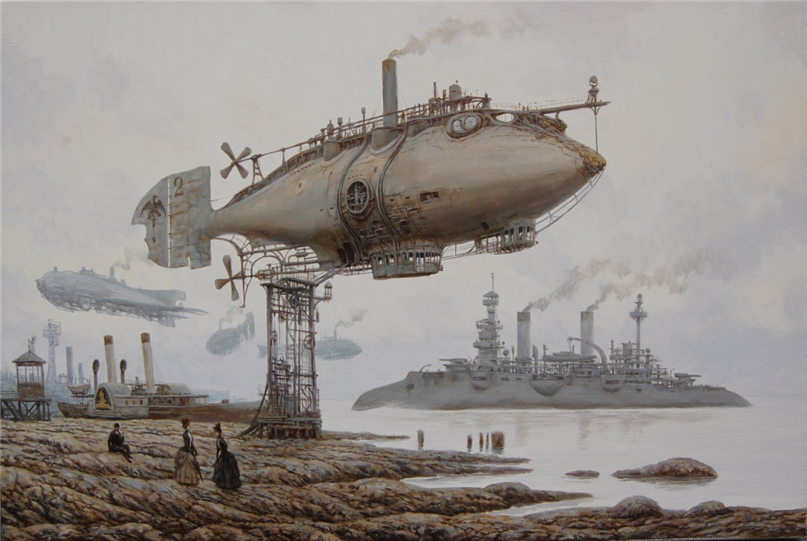The Case for Steam (almost)
In part one of this series I talked a bit about why I'm working on a "practical" design for an Airship. I also mentioned that one of the main fantastical elements was the super powerful energy source that will power the ship. So in this article I will start to make the case that given this very good energy source the best lifting gas system to use is simple steam.
I thought I would be able to get right to making that case, but first we need to talk a bit about how a conventional gas filled airship flies.
 |
| Graf Zeppelin 1933 |
Unlike a surface or underwater vessel however, the airship is moving through a medium that is more than 700 times less dense than water. A ship floats by displacing water equivalent to the weight of the vessel. Since water is so much denser than air a ship hull can be quite small and still be able to support a significant weight. Plus there is a definite interface between the water and the air so a ship can act like a platform resting on this surface and have all it's "interesting stuff" exposed on top of the hull, in the air. A surface ship usually has a significant amount of reserve or excess buoyancy, which is why a ship floats on the surface and can carry useful amounts of cargo and armaments.
An airship also floats by displacing a volume of air equivalent to it's weight but, since air is so much less dense the volume required is correspondingly higher. There is essentially no "surface" to the air so an airship is more like a submarine than a surface ship. The airship is suspended INSIDE the air it moves through so it needs to be as close to neutrally buoyant as possible. That is, the buoyancy should be sufficient to allow the airship to be stable in altitude but not tend to rise or fall. If the airship is positively buoyant by too large an amount it will rise uncontrollably unless lift gas is vented or buoyancy is otherwise reduced. If it's buoyancy is too negative it will not fly at all or fall to the ground unless weight is reduced by dropping ballast.
In practice airships are usually slightly heavy relative to this neutral point, I'll explain why in a moment.
Since there is no surface against which an airship's hull can push, like a surface ship pushes against the water's surface, there is no "right-side up" except that determined by the distribution of weights in the hull. This distribution is critical, relatively heavy portions of the craft will tend to twist the hull until they are at the lowest point. Thus even though it is popular to show some Steampunk Airships looking like airborne surface ships it would take a lot of external force, with complex engines and propellers , to keep them that way. Our airship will have the traditional weight distribution where the lowest part is filled with the heavy stuff, engines, power source, crew, cargo, cabins, and most weapons. The large volume needed to make the vessel float in the air will be above this.
The other thing that powered airships use in flight is what I call dynamic or form buoyancy. That is, the movement of the ship through the air generates some of the needed lift. This is in addition to the static lift supplied by the large volume of lifting gas, much like the passage of air over the wing of a heavier than air craft. In the case of the original Zeppelins, and current non-rigid airships, most altitude control in flight was by judicious use of the control planes to change the hulls angle to the airflow. They use the effect of the ships forward motion through the air to control altitude. That is the reason to keep the airship slightly heavy. By having the airship tending to sink in the absence of forward movement the pilots can play the opposing forces against each other which makes control easier.
Airship flight is a constant balancing act between the forces supplied by the vessels buoyancy and propulsion, and the external forces caused by air movement across the surface of the vessel, and any larger atmospheric conditions like winds, frontal systems, storms etc. In a traditional gas filled airship there were three constraints that determined the length of time an airship could operate. The three were fuel supply, ballast supply and lifting gas supply.
Adjustment for external conditions, like altitude, temperature, humidity etc, required the release of ballast, usually water, to increase buoyancy, or venting of gas to decrease it. As fuel was consumed during a flight the vessel would get lighter with time so gas would have to be vented to maintain static altitude. Obviously there is a limit to how much ballast could be carried, simply to be dropped, and how much gas could be vented before the ability to control the buoyancy would get problematic.
Any emergency conditions, like being caught in a sudden updraft or downdraft near a weather front, could necessitate the dropping of a lot of ballast at once or the venting of a large amount of gas. A single such incident could result in the vessel being unable to continue its voyage, if she survived at all.
Here, finally, we can begin to discuss the case for steam as the lifting gas, because the use of steam essentially removes two of these three constraints! In our case our amazing power source also removes the third, completing the trifecta.
In my next post in this series I'll get to the heart of the Steam as Lifting Gas case.
Until next time here is another image from the Steampunk Art of *Voitv to inspire our airship dreams...
 |
| Postal Dragon |
Keep your sightglass full, your firebox trimmed and your water iced.
KJ
Click here for the next part of this series.
You can follow the full design thread by clicking on the tag "Flight Engineer".



~ 0 comments: ~
~ Post a Comment ~